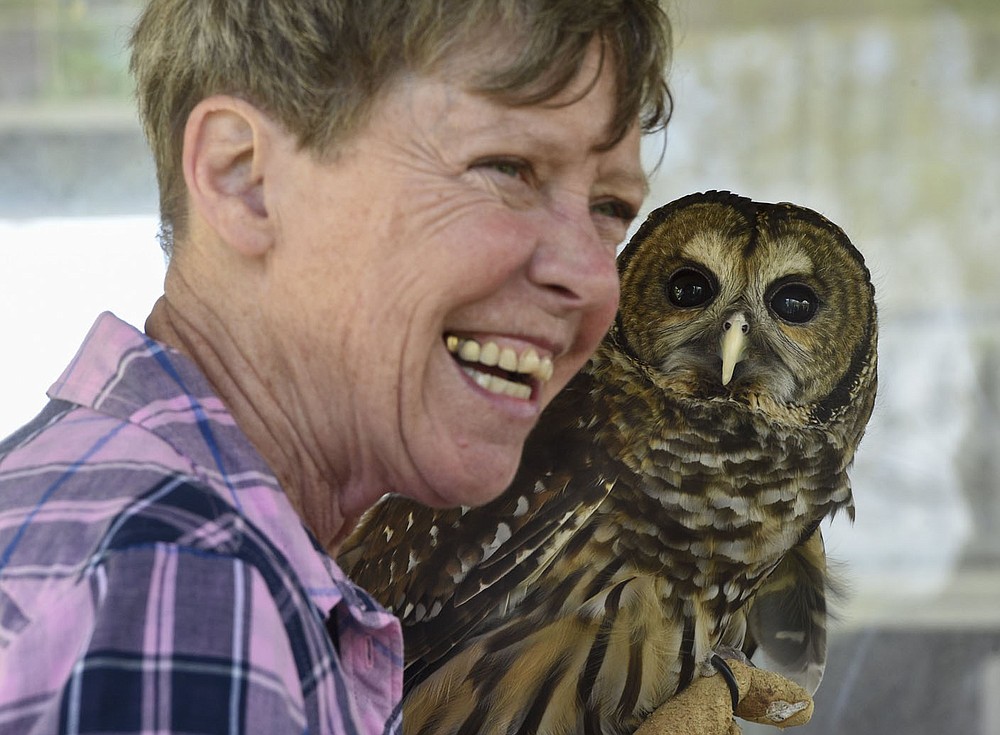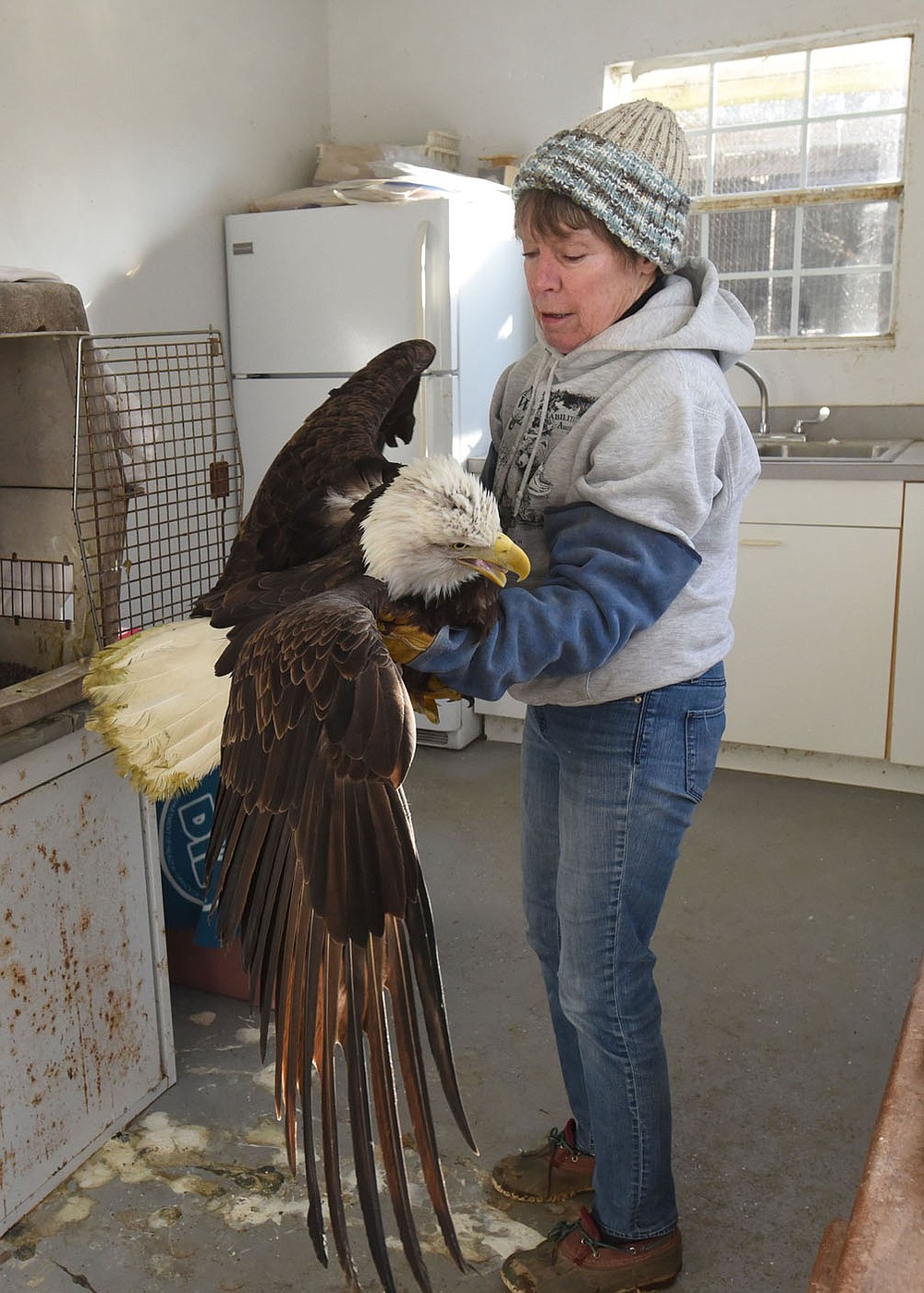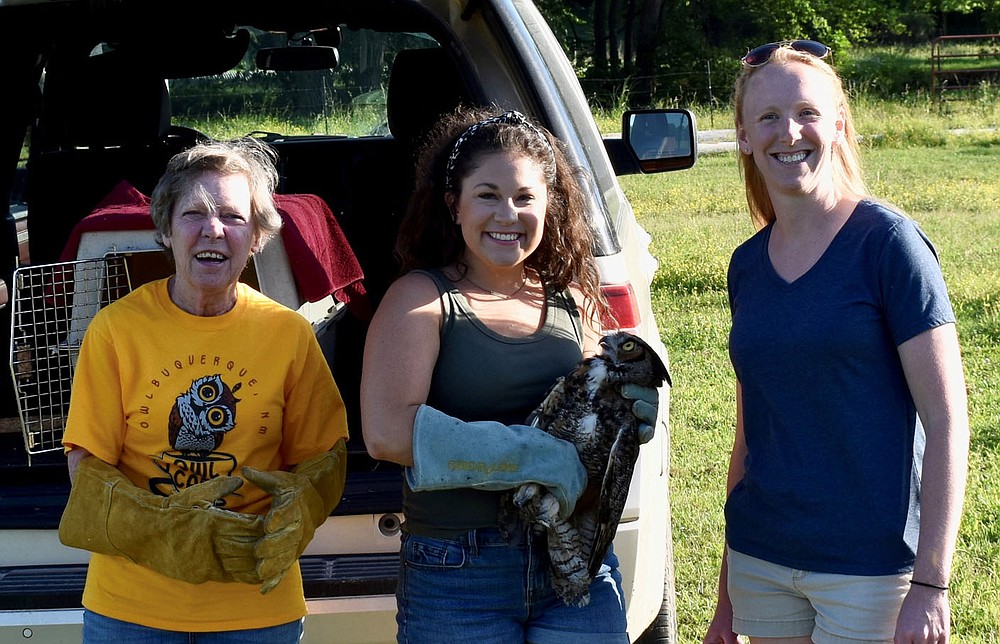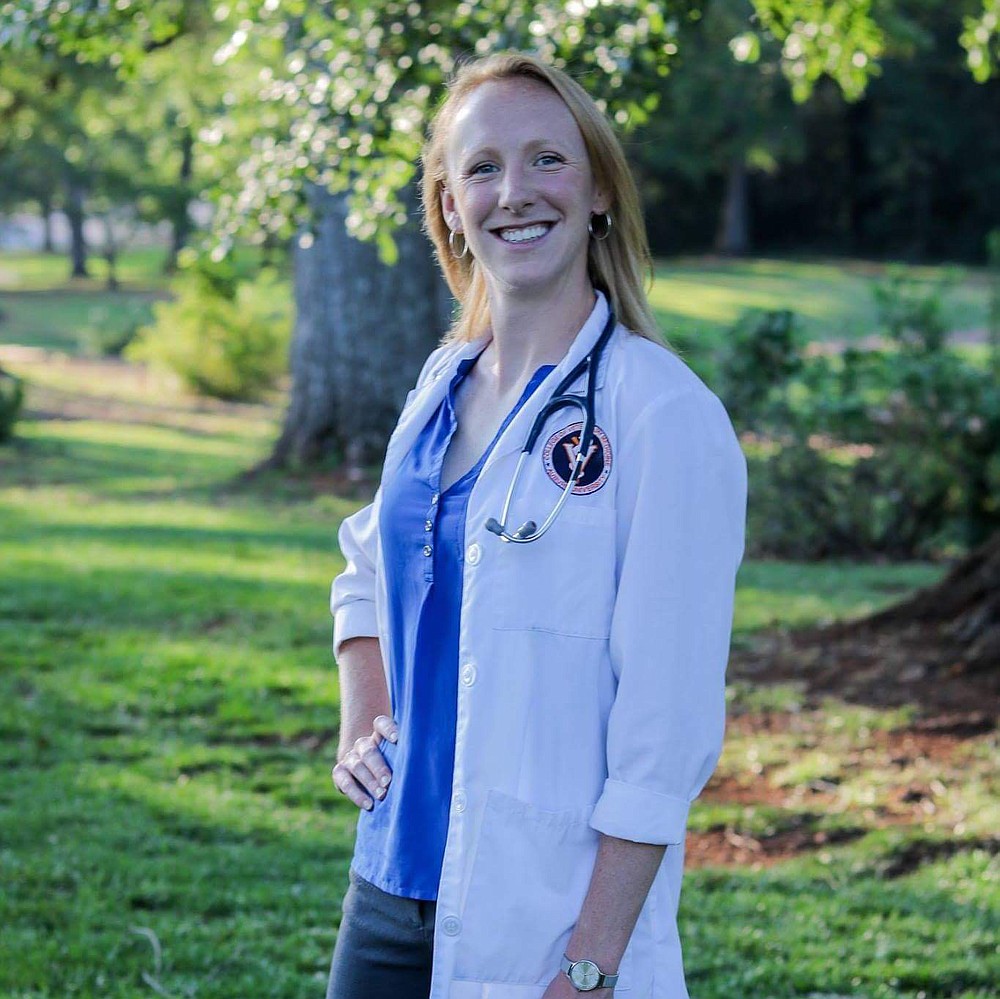An injured baby bird found far from its nest; a hawk, hit by a car; a poisoned owl, slowly wasting away -- if you've ever experienced that helpless, panicky feeling of wanting to help a wild animal but having no idea how to go about it, you know the incomparable value of wildlife rehabilitators who have all the answers. Take, for example, Lynn Sciumbato, founder and operator of the Morning Star Rehabilitation Center outside of Gravette: For 35 years, she's been at the forefront of wildlife rehabilitation in Northwest Arkansas, a job so large that several years ago she had to limit her rehabilitation efforts to birds. Wildlife rehabilitation is a niche specialty, and there just aren't that many people with the expertise, making Sciumbato's three-plus decades in Northwest Arkansas an extraordinary contribution. Now, she's getting a little more help: In 2020, veterinarian Emily Warman formed Northsong Wild Bird Rehabilitation, a nonprofit organization with, according to its press materials, "the goal of developing a sustainable way to provide avian wildlife with medical care and rehabilitation."
"I was reviewing [Sciumbato's] data when I was putting together some information to start Northsong, and, between 2017 and 2019, approximately 1,200 birds were brought to her," says Warman. "So there's definitely a need for this in the community. Right now, she's doing it all on her own, with consultation with local vets. My goal is that we get a true wild bird center up here so it can help alleviate some of her massive caseload. And it will also allow, hopefully, for more people to be aware that it's an option. Because, you know, those 1,200 animals, they were brought in by, to put it bluntly, people who went out of their way to figure out where to bring that bird. I think a lot of people probably just don't know what to do with wildlife and, so, unfortunately, [injured] birds get left [behind]."
Building her nest
Ecology and biology are lifelong interests of Sciumbato's, who was a biology teacher for more than 20 years at Rogers High School. When she first got interested in wildlife rehabilitation, she studied with Joe and Vivian Stockton of Siloam Springs, a husband-and-wife team of wildlife rehabilitators who made enormous contributions to the field.
"I always say they were doing rehab before it was cool," says Sciumbato. "They wanted to retire, but when you're the only person doing something, it's really hard for you to retire. So I raised my hand and have been doing it ever since. At the time, I didn't really realize it would take over my life."
Sciumbato's workload, in fact, is enormous, partly because she's one of the only people in the area with the scope of expertise necessary to do the job and partly because she's one of the only people in the area with the federal permit that allows her to take in, care for and rehabilitate birds. Migratory birds are federally protected by the Migratory Bird Treaty Act of 1918, and because they are, rehabilitators have to apply and qualify for a federally granted permit. Sciumbato says there are only a handful of people in the state of Arkansas who are currently permitted.
"Winter is when I get in raptors," she explains of the constant but varying work. The category of raptors includes all birds of prey like hawks, eagles, falcons and owls. "I'm way more apt to get hurt raptors in winter time than in the summer, so, for those, at any given time, I can have anywhere from three to 30 in residence. Spring and summer, when I'm working with baby birds, I'll get hundreds. In the middle of the summer, I'll probably have 50 to 60 little songbirds going, from nestlings on up, that have to eat constantly, so that's my busiest time of year. Raptors don't usually require the intensive care -- every 30-minute feedings -- but they do have treatment and have to be fed."
The way Sciumbato describes it, caring for nestling songbirds is a lot like having a couple dozen newborn babies to care for -- albeit newborns that sleep through the night.
"As they get older, they don't have to be fed quite as often," she says. "But their first couple of weeks is pretty labor intensive. The good news is that, because most songbirds have very poor night vision, they can't forage or feed their young at night, because they can't see. So the babies are fed sun up to sun down -- by their parents or by me. The babies sleep through the night."
"The coolest story I have about her was from around 1993 or 1994," remembers retired Arkansas Game and Fish Warden Brian McKinzie, who has worked with Sciumbato since 1991. "We had a botulism problem from people dumping chickens illegally, and I took Lynn, in two days' time, around 67 hawks. There were a few owls involved in that, and a few bald eagles. And at that time, Lynn was a full-time biology teacher at Rogers.
"I've showed up at her place at 2 o'clock in the morning, 7 o'clock in the morning, 3 o'clock in the afternoon," he continues. "There's no telling how many animals I've taken her over the years. ... Nobody could ever repay the things that Lynn Sciumbato has done [for the community]."
The goal of wildlife rehabilitation is always to release the animal at the end of treatment period, but Sciumbato does have a few birds whose health prohibited release back into the wild. She uses them for ambassador purposes and takes them to schools, state parks, Boy Scout and Girl Scout meetings and library events.
"I have always felt like it seems as though kids are getting further and further away from nature," she says. "But once you've met one of these birds up close and personal, you're more apt to want to save them."
"She's giving the audience, kids of all ages, a chance to see these birds up close, see how big they really are, and to see how majestic they are," says Jay Schneider, assistant superintendent of Hobbs State Park-Conservation Area, who has worked with Sciumbato on a number of educational programs. "And, in turn, teaching them about certain things that humans are doing that aren't good for them.
"If there were ever someone we needed in the community, it's her, to help care for those birds," Schneider adds.
On the wild side
Veterinarian Emily Warman was just a month into her undergraduate studies at Auburn University when she came across an informational booth for its Southeastern Raptor Center. A fascination with wildlife was ingrained in the Alabama native; she had grown up frequently visiting the Alabama Wildlife Center, just 30 minutes down the road, and her father passed on a love of nature to her. But the chance to get up close and personal with the kinds of birds of prey you usually only see soaring through the sky launched her fascination into passion. One look at the one-way glass windows that let her study a raptor in recovery, and she was hooked. She signed up to volunteer with the organization and worked there through her veterinary studies.
"It started with just learning how to handle raptors, how to feed them, the husbandry, and then, after I got into veterinary school, I learned some of the medicine behind it and the treatments," says Warman. "After that, I started doing a few other externships and internships to get additional information, because it's quite a niche."
When Warman graduated with her Doctor of Veterinary Medicine in 2017, she went on to complete medical rotations and internships at the Alabama Wildlife Center, the California Wildlife Center, the Birmingham Zoo and the American Bald Eagle Foundation. The call to dedicate her career to the care and handling of wildlife was strong, but Warman craved more interaction with the public than would be possible with that kind of focus. Today, she's a small animal veterinarian with the Rose Animal Clinic in Bentonville with a secondary interest in wildlife. Four years ago, Warman and veterinary technician Madison Kennedy started working in collaboration with Sciumbato.
"I have a specific injury interest in orthopedic issues, so a lot of times Lynn will bring me birds that have broken wings, broken legs, any kind of movement/flight problem," says Warman. "They'll come to me, and Madison and I will assess them a bit with Lynn and come up with an appropriate treatment plan. I've done a lot of surgeries on fixing legs, fixing wings, things like that. But once we're done with our treatment plan, the bird will go back to Lynn [for recuperation and release]."
The relationship is a symbiotic one: Warman and Sciumbato share a love for birds and a passion for wildlife rehabilitation. Sciumbato needed Warman's veterinary skills, and Warman needed Sciumbato's federal permit and three-plus decades of experience.
"The current law is that a wild animal can be brought into a veterinary clinic, and, essentially, the clinic has 24 hours, on average, to stabilize it," Warman explains. "But then they have to transfer it to the treatment of a licensed rehabilitator. A veterinarian cannot legally treat [the animal] without having a permitted wildlife rehabilitator there."
Grounded
Sciumbato and Warman say there are a variety of reasons birds may end up under their care. One thing that some might find surprising is that birds being hit by cars is one of the most common injuries.
"Basically, what we have done is we have made a perfect hunting ground for hawks and owls," says Sciumbato. "They've figured out when you have a place with mowed grass or asphalt, anything that moves is going to be so easy to see, so we've made hunting easy for them alongside roads and interstates. So they're hunting there, and they're not really looking out for cars, they're looking at the field mouse. And, sometimes, they'll catch something big and will fly in front of a car but because what they're carrying is so heavy, they can't lift above it."
"For bald eagles, the No. 1 thing we see is lead poisoning," says Warman. "Unfortunately, we still have a lot of lead ammunition that is being used, and that's detrimental to our avian wildlife. Most commonly, a bullet is shot around some kind of carcass, and it splinters. Bald eagles are very lazy birds. They would rather eat off of fresh meat, something that's not moving fast, versus hunting like a hawk. So most of the time, they'll actually ingest lead fragments by accident while trying to eat whatever dead prey is there."
Repair and recuperation is extensive and time consuming; birds can be under the care of Sciumbato and Warman for weeks, even months.
"When they come in and have broken bones, there's usually two big options," explains Warman. "One, we can do what's considered the conservative treatment, put it in a cast almost, and the other is a surgical treatment. Madison and I do the whole shebang -- we put the pins in, we do physical therapy, usually every three to five days for three or four weeks. And then after the bone is healed, we'll pull the pins or the hard wire on it. It's really similar to treating broken bones in people."
It's grueling, painstaking work, often with heartbreaking outcomes.
"Madison and I, we've actually been pretty good with our success rates," notes Warman. "Back when I was an undergrad, I did a lot of research on success rates because, unfortunately, wildlife patients, they just don't come in in great condition. So if you're hitting a 50 percent success rate, that's incredible."
Kennedy says she was introduced to wild bird rehabilitation by Warman, and -- in an echo of Warman's own conversion to the practice -- was immediately enthralled by the process.
"It was something I had never experienced before," she marvels. "Even though a lot of them had been hit by cars or had broken legs, they were still so majestic and special. I wanted to be a part of helping them. I was truly thankful she introduced me to them -- they're fascinating creatures."
There's a steep learning curve to how to handle raptors, she says -- and a lot of differences between them and the domesticated animals she was used to handling.
"Because of their size and the fact that they're not used to human contact, it makes it kind of dicey when you start working with them, especially if you're not educated on how to properly hold them, how to get around their talons and beaks," says Kennedy. "Because of their air sacs, you can't hold them tight or squeeze them, and they handle anesthesia completely differently. Their treatment and recovery is completely different. And the main goal is to get them back out into the wild -- if you can't place them in an educational facility or out in the wild, it puts more stress on the animal than they should have to tolerate, and so humane euthanasia is our best bet. It's a little more black and white than for domesticated animals."
"Birds are really finicky creatures," adds Warman. "If you stress them out enough, they will just die, so we have to be efficient in what we're doing."
Euthanasia or death from their injuries are all-too-common worst case scenarios for the wild birds Sciumbato and Warman have taken in, and both are pragmatic and matter-of-fact about that. But what fuels their optimism and determination are the occasions when they release a patient back into the wild.
"Of course, that's the best part of rehab -- letting them go," says Sciumbato. "So many, especially with the raptors, come in that can't be saved, and that's just the way it is. If they're hurt or sick enough to be picked up, they're not in good shape to start off with, so many can't be saved. The ones that can -- it's a joy. And what a feeling of accomplishment!"
"It's unreal," says Kennedy. "It's hard to put into words, how it feels. You go into it thinking, 'The bird will fly off and it will be cool,' but it's a lot more than that. You think of all the hard work that not only we did, but what the bird went through, as well -- breaking its wing, its leg. A surgery, a repair, they have to go through rehab, and they get so stressed. Then you get out to this open field, release them, and they fly off, and they're so happy. You get this explosion of emotions and think, 'This was meant to be.' You think, 'This is probably the coolest thing I've ever done, and not just anyone gets to do this.' You really understand the magnitude of it."
"Birds, and wildlife in general, don't have the advocacy for their health or for their well-being like our domestic creatures have," notes Warman. "Those animals are living in someone's house, and someone is watching over them every day. Someone has taken responsibility for them. But, for wildlife, that's not the case. A lot of times, they're on their own, and, if they're lucky, a Good Samaritan will find them and get them where they need to go. Every single release that I've been a part of has been just as exhilarating as the last, because every single person who got that bird to that point -- from the Samaritan that picked it up to the volunteers that helped get it rehabilitated -- played a role in that bird's life being spared. And I think that's really great. And I think other people feel the same way when they've been a part of it. Each one, when it goes back into the wild, is just incredible. A victory."
Taking flight
Warman officially kicked off Northsong Wild Bird Rehabilitation in 2020 and is currently seeking 501(c)3 nonprofit status from the IRS. Press materials from the organization say NWBR's mission is "to design a medical facility that will meet federal requirements for United States Fish and Wildlife permitting and allow for free diagnosis and treatment of wild avian patients for years to come. NWBR plans to promote environmental conservation, sustainable growth and quality of life for both humans and animals in the Northwest Arkansas region." In short, Warman and Kennedy hope it will become an educational resource for Northwest Arkansas, save even more sick or injured birds. and make Sciumbato's work much easier. All of these details are clearly exciting for Warman to talk about, but she presents the details about the educational aspects of the project with a particular enthusiasm. After talking to Sciumbato, Warman and Kennedy, it's a recurring theme: This is a specialized wildlife service, a labor of love, that's passed from person to person, almost like folklore. Sciumbato learned it from the Stocktons, Warman from Sciumbato and other professionals and Kennedy from Warman. Now it's time to pass the passion on to others.
"Miss Kennedy has been helping me develop all of this," says Warman. "We're going to develop courses for people to go through. So they [would] learn about the different species, get a certain knowledge base, and then those volunteers would do what I did when I was starting out at Auburn -- the husbandry, the feeding, the medicating. People have a huge interest in working with and learning about wildlife, so I think it would be a great opportunity for the Northwest Arkansas region. It would be a once-in-a-lifetime opportunity for a volunteer, because they would be able to help the community, but also they would get a one-on-one experience with a bird that's rehabilitating that they'll never get elsewhere."
Ultimately, enlisting others in the effort is imperative to protecting the vulnerable wildlife of Northwest Arkansas. The chain must be continued.
"Of course, it's always been in the back of my mind for a few years now that I won't be able to do this forever, and there was nobody to take over once I'm unable to do this, or even dead," says Sciumbato. "And that's been an interesting phenomenon. I'm online with a bunch of raptor rehabilitators, and it seems like almost all of them are my age. I'm close to 70, and it seems like there was a generation of a lot of us doing this countrywide. Finding people to take over the reins has been, not just a problem for me, but for others in the country, too. The fact that Emily wants to do this -- it takes a huge weight off of my mind. This will continue, even when I'm not here."




How to Help
Both Lynn Sciumbato and Emily Warman say finding funding for wildlife rehabilitation is a difficult prospect.
“It’s all on her own,” says Jay Schneider of Sciumbato’s efforts. “She takes donations, and we do work hard to help her with that.”
Likewise, Warman says grants to fund wildlife rehabilitation efforts are scarce, and many of her hopes for the Northsong Wild Bird Rehabilitation Center hinge on future funding from individual donors. Until the organization’s 501(c)3 status is approved, Warman cannot accept donations, but says those interested in funding the center may donate through the website when that time comes, as well as sign up to volunteer.
Morning Star Wildlife Rehab Center
13844 N. Mount Olive Rd.
Gravette, AR 72736
Northsong Wild Bird Rehabilitation
https://ift.tt/2Pyw8y8
"bird" - Google News
March 07, 2021 at 02:09PM
https://ift.tt/38jnnP3
For the birds - Arkansas Online
"bird" - Google News
https://ift.tt/2s1zYEq
https://ift.tt/3dbExxU
Bagikan Berita Ini















0 Response to "For the birds - Arkansas Online"
Post a Comment